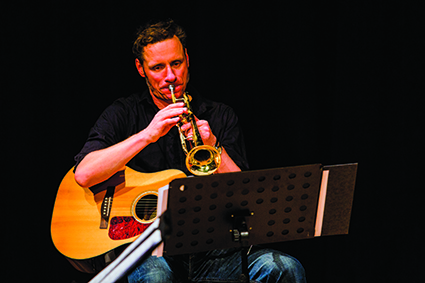Eclectic fusion
Angus McPherson: Jochen Gutsch & The Hinterlandt Ensemble

Jochen Gutsch
photo John Frape, copyright Campbelltown Arts Centre
Jochen Gutsch
We hear Bronwyn Cumbo’s amplified violin before we see it. A forlorn melody heralds her entrance from behind a curtain. A second violin voice is soon added as Natalya Bing enters from the other side of the stage. The peripatetic violinists feed off each other, the music an improvisatory conversation until they reach their music stands and settle into a rhythmic ostinato. Jochen Gutsch takes to the stage on electric guitar, his sound dry and percussive. The final member of the quartet, Simeon Johnson, joins on electric cello. Described by Gutsch as “a truly collaborative work that has the handwriting of all four members in it,” the world premiere of Patches and Paths is the result of The Hinterlandt Ensemble’s week-long residency at Campbelltown Arts Centre.
The opening rhythmic figure intensifies before it segues into a more conventionally tonal idea: Gutsch strums a chord progression while the violins trace repeating scalic patterns. Johnson taps on his cello’s frame, sending a deep bass percussion beat through the speakers. This motif becomes an almost pop-style refrain throughout Patches and Paths that the ensemble returns to between more adventurous excursions.
The components of a drum kit are scattered between the players, drums and cymbals used to highlight cadences and climaxes—the suggestion of a drummer without the saturating repetition of a relentless drum beat. Distortion kicks in on electric guitar and cello, Gutsch’s rock background making itself heard. Despite the raw sound, the balance is sensitively controlled and the ensemble maintains the feeling of chamber music’s intimacy.
The music darkens; electronic pedal effects throb. Rhythm and pitch disintegrate and drift. Sweet high notes from Gutch’s guitar add a naivety that is soon undercut by the intensification of the electronic manipulation. Freer episodes such as this intersperse with the rhythmic patterns and chord progressions of rock and pop music. At one point the music shifts completely into an electronic world: synthetic warbles and slides flutter at Gutsch’s fingertips on a console. At other times the tonality is conventional, Gutsch strumming guitar or playing a nostalgic trumpet line over the string trio.
Patches and Paths reaches its conclusion fading into a wash of atmospheric electronica. Players leave the stage one by one, but Gutsch remains at the controls. Memories of earlier melodic material emerge from the fog of sound, but soon decay. Gutsch exits and the ambient noises dissipate into silence.
The first half of the concert comprised two acoustic works by Gutsch, written specifically for Hinterlandt. Alltagswelt (Everyday World) opens with a spiky repeating pattern on guitar. Bing and Cumbo join (staggered entries are a recurring theme) with short measured trills on violins before Johnson initiates a rising figure that passes around the strings. Gutsch alternates between guitar and trumpet; the five-movement work touches on genres including rock, folk and Spanish music, as well as improvisatory passages that wander into the atmospheric—a cloud of siren string glissandos and guitar slides.
Like Alltagswelt, Umgangswelt opens with a rhythmic pattern. Cumbo begins an unsettled heartbeat on xylophone, Bing joining on a second xylophone to fill the off-beats. The title translates less readily into English, but suggests interactions and social frameworks. Though Gutsch describes Alltagswelt and Umgangswelt as “similar in length, structure and aesthetics,” the colour palette of Umgangswelt is expanded: xylophones, glockenspiel, woodblock, bass recorder and bamboo wind chimes augment the regular line-up of violins, cello and Gutsch’s guitar and trumpet. The music meanders through disparate worlds: from layered rhythmic grooves to burlesque circus music.
Gutsch announces the encores as “fun” pieces. The first is “Tiny Ugly World” by psychedelic punk rock band Alice Donut. Gutsch sings and strums acoustic guitar, Cumbo, Bing and Johnson providing back-up vocals. Tom Waits’ “No One Knows I’m Gone” follows. Gutsch plays the vocal line on glockenspiel, an innocent chiming to replace the melancholy lyrics, while the string trio accompanies.
The Hinterlandt Ensemble expands the intimacy of classical chamber music to an eclectic fusion of styles. The long-form works took the audience on journeys through diverse sound worlds, the unconventional line-up of instruments creating unique possibilities and timbres. The wandering narratives could be unsatisfying at times; Patches and Paths in particular felt rather episodic. Fascinating ideas were presented but often passed by before they could be developed or explored in depth. That said, the ensemble’s cohesion and refined musicianship drew the audience in, inviting listeners to immerse themselves in shifting musical landscapes.
Jochen Gutsch & The Hinterlandt Ensemble, residency performance, Campbelltown Arts Centre, Sydney, 2 Oct
RealTime issue #130 Dec-Jan 2015 pg. 52






